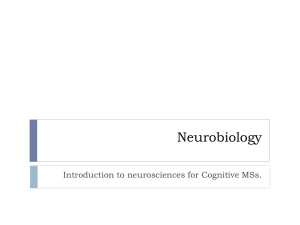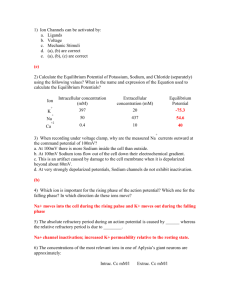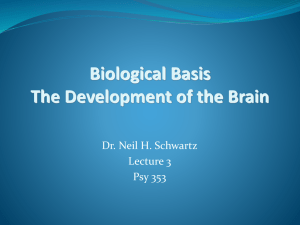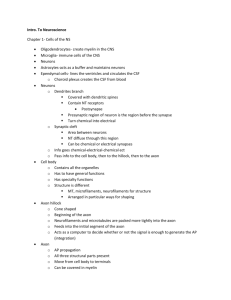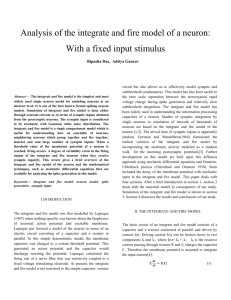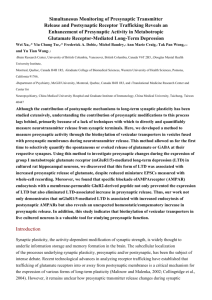Nerve
advertisement
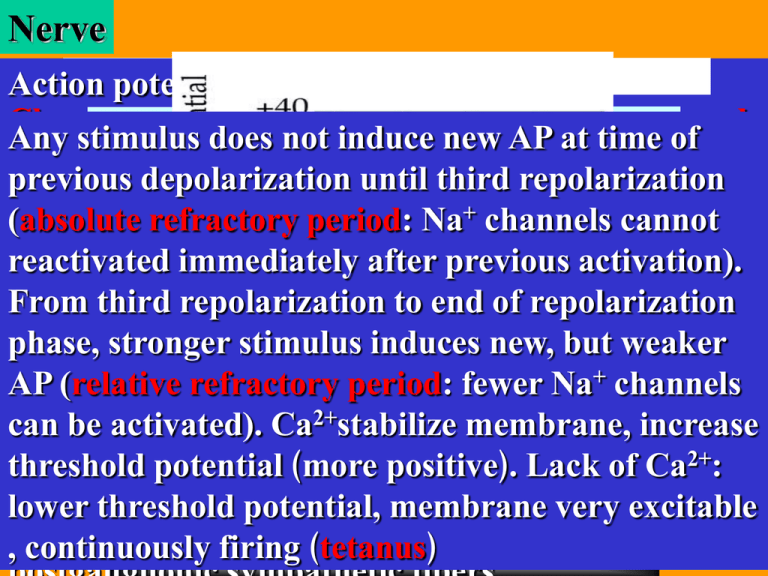
Nerve Action Nerve cell Resting potential membrane is neuron,potential 100 billion neurons ± 1006 Classification according to conduction velocity and differ in structure, chemistry & function. Neurons Any stimulus does not induce newincrease AP at time of Phases ofglia AP in neurons: Ionic fluxes causing electric phenomenon of RMP: Cathodal Types of stimuli, local responses, & caliber of nerve fiber. From larger to lowerhave Nerve and muscle cells are excitable cells, the confer unique functions of nervous system. Glia are + + + previous depolarization until third repolarization Depolarization phase: Sharp rise, 0 potential, Ion Extracellular Intracellular -Na -K pump: extrude 3 Na outside cell, intrude 2 decrease Astrocytes: with Regulate amplitudes EC space, of stimuli, remove subside (or restrict after caliber: ability to reverse the negativity of their membrane All living cells (animal or plant) exhibit potential supporting elements, 10 times as neurons. Neurons + +channels, + + (absolute refractory period: Na channels cannot overshoots,about +35 mV (activate all Na Classification of nerves K inside, much positive ions outside 142 mEq/L 10stimulus mEq/L velocity Na removal movement of of) these neurotransmitters stimuli. Sufficient raises Accordingly, RMP of nerve cell –70 mV, PROTEINS¯ Aα largest diameter & fastest conduction potential in response to a sufficient external difference across their plasma membranes when contain cell body (soma or perikaryon) & neurites +,previous ++ reactivated immediately after activation). inrush of huge number of Na PM lose negativity Physioanatomic classification: afferent 4 mEq/L 140 mEq/L -Na channels are inactive at rest, voltage gated, K the Oligodendrocytes: membrane potential Myelinating 15 mV glia above in RMP CNS, (i.e. form – 3Na skeletal muscle s –90 mV, cardiac muscle –85 mV e.g. somatic motor & proprioceptive nerve fibers stimulus. The external stimulus may be electrical, microelectrodes are inserted into cells, membrane (axons & dendrites). Cell body gives rise to single – + PHOSPHATES¯ From third repolarization to end of repolarization Repolarization phase: Rapid fall toward negative 103 mEq/L 4 mEq/L ClmV);sheath (sensory) & phases efferent (motor), subdivided intoin activated by electric current 55 myelin AP (wrap will around start axons, & does function not stop untilto Pump & smooth muscle isor variable but nearly –50 mV. Aβ e.g. sensory fibers of fine touch & fine pr. chemical, physical other types of stimuli. This interior is negative in relation to its exterior. This is axon which conducts nerve impulse from neuron + + + 4 mEq/L 75 mEq/L phase, stronger stimulus induces new, but weaker Phosphates potential (inactivate Na channels, continuous somatic & visceral neurons, general &gradient, special CHLORIDE¯ -Passive diffusion of K outside, conc. 2K complete insulation), cycle interruptions: occurs, all-or-none nodes of rule. Ranvier. Membrane Aγ e.g. motor fibers to muscle spindle. change in membrane potential is action potential. resting membrane potential (RMP), due uneven the next, up to 1 meter length, speed of impulse is a +to + +channels 30 mg/dL 200 mg/dL Proteins AP (relative refractory period: fewer Na pumping of Na & passive diffusion of K outside) neurons. diffusion potential, major factor of RMP potential Schwann at Cells:PNS, which AP myelin starts is sheath threshold & neurolemma or firing Aδ e.g sensory fiber of acute pain, crude touch cold Response in nerve cell is transmission of nerve + distribution of ions in & outside membrane. function of diameter. Dendrites: small (rarely more 2+ K can be activated). Ca stabilize membrane, increase Hyperpolarization phase: Decline more negative -Cl ions still inside, due to higher conc. outside potential. Microglia:Scavenger Subthreshold cells stimuli get rid no of or foreign local effects, particle B e.g.2mm)& preganglionic autonomic nerve fibers. impulse while response in muscle cell is contraction than organized symmetrically (antennae). 2+: + threshold potential ﴾more positive﴿. Lack of Ca potential than RMP,–72 mV (slow closure of K -Anionic proteins & phosphates stay inside, large supramaximal stimuli the same effects as threshold C smallesttree: diameter unmyelinated fibers e.g. Dendritic all neurites. Neural signals: efferent lower threshold potential, membrane very excitable channels, after that, RMP again) size, PM impermeable Home Exit or sensory fibers of chronic pain, heat, gross pr. and (away) afferent (towards) cell body. BASIM ZWAIN LECTURE NOTES , continuously firing ﴾tetanus﴿ Nerve 12-Several Propagation Synaptic 910-Single 11-Axon Occlusion collaterals and presynaptic presynaptic of junctional means action from that neuron potential neurons transmission postsynaptic the sum may may of diverge converge activities neurons by its on of may singleand axon reverberate several postsynaptic neurons its to collaterals the working presynaptic neuron. into together several neuron(s). is postsynaptic less than the 4-Synaptic Acetylcholine: potentials In neuromuscular are either excitatory junction (NMJ), (EPSP) Myelin prevents leak, nodes of Ranvier act as AP triggered in axon hillock, presence of large No. Criteria for classification as a NT neurons. sum of their activities when they work separately. Properties Classification of synapses: of neurotransmitters 11Synapses: chemical or electrical:(very rare: e.g gap or preganglionic inhibitory (IPSP). ANS, postganglionic EPSP: depolarization: parasym., cations basal 13Several successive EPSP may facilitate synaptic + augmentation stations, strengthen wave of depolarof Na channels & transmitted along axonn.formem. same Vesicles fuse with active zones of presynaptic -Must be synthesized & stored in presyn. Works separately on 2 neurons 1-One-way A. Small molecule, conduction rapidly from acting preto transmitters: post-synaptic B. Neuropeptide, slowly acting transmitters: junction, current flows directly through specialized + CAT in forebrain or anions & out, brain while stem IPSP: complexes. hyperpolarization: Synthesized knob to depolarize while several successive IPSP Synapse is junction between two neurons. The first ization by triggering new AP, nodes are rich in Na reason, huge number of positive charges incontains firing NT diffuses across synaptic cleft to bind its specific -Must be released by presyn. n. upon stimulation neurons Class because I: Acetylcholine post synaptic membrane Acetyl coenzyme A + knob. choline Acetylcholine a-Hypothalamic-releasing hormones. protein molecule:connexon, distance between two 5-EPSP from acetylcoenzyme-A & IPSP present & simultaneously choline, catalyzed in cleft. by may inhibit synaptic is presynaptic neuron and the other is postsynaptic channels, saltatory conduction, jumping from node segment of membrane is equilibrated by adjacent receptor on postsynaptic mem. Several types of NT -Application of NT directly to target cell must Temporal summation no Class synaptic II: vesicles. The amines (adrenaline "epinephrine", Electrotonic flow of current Presynaptic N b-Pituitary peptides. sides of membrane is very small: 5nM). Chemical: 6-Synaptic cholineacetyltransferase potentials are enzyme not all-or-none (CAT), Ach potentials. is 14Continuous recurrent weak synaptic potentials neuron. Between them is synaptic cleft. to node, one direction from soma to axon terminal segments, electrotonic flow of current, very fast available and each may have typesdopamine, & subtypes of ACE produce same effects as NT release 2-Synapse noradrenaline is a site "norepinephrine", of neurotransduction (from c-Peptides that actbyonacetylcholinesterase gut and brain. predominant, neurotransmitters (NT) synthesized 7degraded 0.5 ms is in synaptic cleft delay enzyme may cause habituation of postsynaptic neuron, not (orthodromic conduction), not antidromic: absolute Acetylcholine choline + acetate Synaptic cleft type of conduction in solid wires, nerve fiber is not2+ receptors. Postsynaptic action depends on nature of Many neurons release more than single NT. electrical serotonine to and chemical histamine). signal). 2+ d-Peptides from tissues. Works separately on 2other neurons & stored in vesicles, AP opens Ca channel & Ca 8(ACE), Spatiotemporal its receptors summation, are nicotinic(complex additive or subtractof 5 α or respond for similar future stimulations. Recurrent Postsynaptic N refractory period, proceeds forward to resting solid wire, leaky, surrounded by sea of electrolytes, receptor. After that, NT must be inactivated by Convergence Neurons that use acetylcholine: cholinergic, 3-Intercellular Class III: Amino chemical acids messages (γ-aminobutyric converted acid into 2+ Divergence Spatial summation influx, increase intracellular Ca conc. attract ive, β subunits) numerous or muscarinic synaptic knobs receptors. on time same Nicotinic: neuron at in strong stimulations accompanied by other weak segment not backward to refractory segment. continuous triggering of AP, cost (0.1 ms each) Reverberation degradation, reuptake, diffusion, or bioconversion catecholamines: catecholinergic, serotonine: intracellular "GABA", glycine, signal. glutamate and aspartate). synaptic vesicles (full of NT) to presynaptic mem., Works separately on 2 neurons same NMJ, time: sym. spatial ganglia, summation, many parts successive of CNS, Muscarinic impulses stimulations may cause sensitization ,serotonergic unmyelinated nerves slowest conduction velocity. , amino acids: amino acidergic Class IV: Nitric oxide "NO". Total together work on 4.... neurons signals NT to release to synaptic cleft by exocytosis. at smooth in sameTotal: synaptic muscles glands. temporal summation. separately workknob: on & 6 neurons Exit BASIM ZWAIN LECTURE NOTES Home






